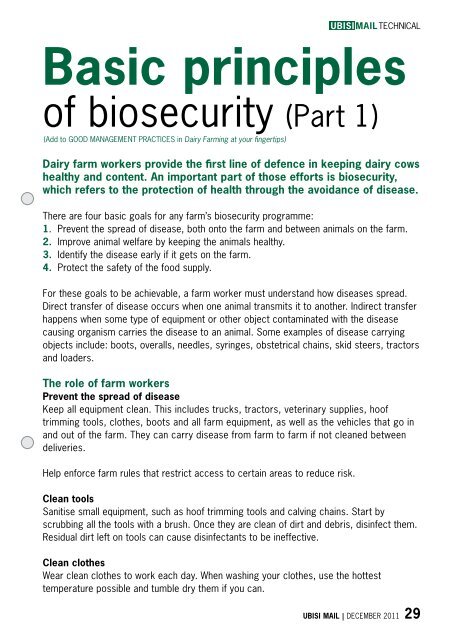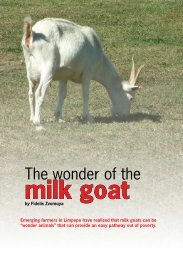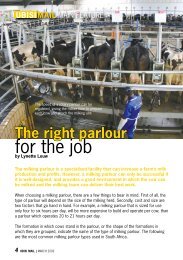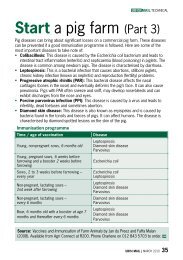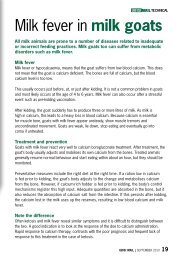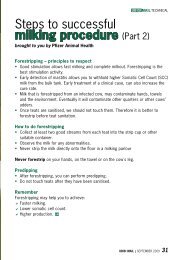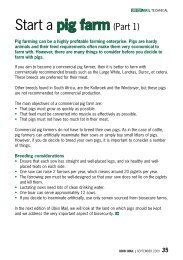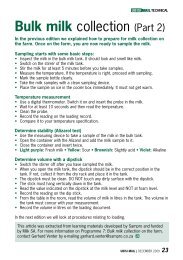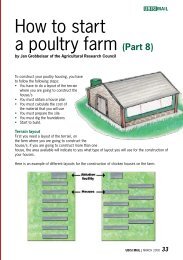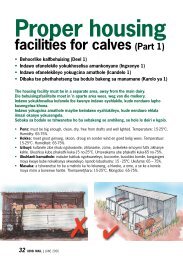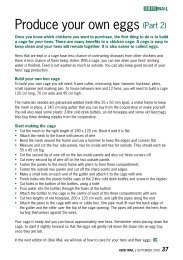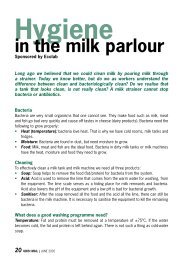Basic principles of biosecurity (Part 1) - Ubisi Mail Magazine
Basic principles of biosecurity (Part 1) - Ubisi Mail Magazine
Basic principles of biosecurity (Part 1) - Ubisi Mail Magazine
- No tags were found...
Create successful ePaper yourself
Turn your PDF publications into a flip-book with our unique Google optimized e-Paper software.
TECHNICAL<strong>Basic</strong> <strong>principles</strong><strong>of</strong> <strong>biosecurity</strong> (<strong>Part</strong> 1)(Add to GOOD MANAGEMENT PRACTICES in Dairy Farming at your fingertips)Dairy farm workers provide the first line <strong>of</strong> defence in keeping dairy cowshealthy and content. An important part <strong>of</strong> those efforts is <strong>biosecurity</strong>,which refers to the protection <strong>of</strong> health through the avoidance <strong>of</strong> disease.There are four basic goals for any farm’s <strong>biosecurity</strong> programme:1. Prevent the spread <strong>of</strong> disease, both onto the farm and between animals on the farm.2. Improve animal welfare by keeping the animals healthy.3. Identify the disease early if it gets on the farm.4. Protect the safety <strong>of</strong> the food supply.For these goals to be achievable, a farm worker must understand how diseases spread.Direct transfer <strong>of</strong> disease occurs when one animal transmits it to another. Indirect transferhappens when some type <strong>of</strong> equipment or other object contaminated with the diseasecausing organism carries the disease to an animal. Some examples <strong>of</strong> disease carryingobjects include: boots, overalls, needles, syringes, obstetrical chains, skid steers, tractorsand loaders.The role <strong>of</strong> farm workersPrevent the spread <strong>of</strong> diseaseKeep all equipment clean. This includes trucks, tractors, veterinary supplies, ho<strong>of</strong>trimming tools, clothes, boots and all farm equipment, as well as the vehicles that go inand out <strong>of</strong> the farm. They can carry disease from farm to farm if not cleaned betweendeliveries.Help enforce farm rules that restrict access to certain areas to reduce risk.Clean toolsSanitise small equipment, such as ho<strong>of</strong> trimming tools and calving chains. Start byscrubbing all the tools with a brush. Once they are clean <strong>of</strong> dirt and debris, disinfect them.Residual dirt left on tools can cause disinfectants to be ineffective.Clean clothesWear clean clothes to work each day. When washing your clothes, use the hottesttemperature possible and tumble dry them if you can.UBISI MAIL | DECEMBER 2011 29
Make sure your boots don’t have dirt on them. Disinfect your boots when moving from onepen to another, especially after working in pens with sick animals.Work with the youngest animals first as they are most susceptible to disease.HandsWash your hands frequently, before you start work, before you eat, treat animals and afteryou finish work. It takes a minute to properly wash your hands.There are six different steps to properly wash your hands. First wet your hands, add soapand then wash them thoroughly, making sure you get the palm, heel <strong>of</strong> the hand, finger tipsand back <strong>of</strong> the hand. Then rinse and dry. Finally, turn <strong>of</strong>f the tap with a paper towel, soyou don’t contaminate your hands again.VisitorsBe aware <strong>of</strong> visitors. Ask visitors to report to the <strong>of</strong>fice or to the owner. If you seesomeone you don’t know, tell your immediate supervisor.Make sure all gates and doors are locked as required. Areas <strong>of</strong> restricted access include:drug storage rooms/refrigerators, bulk tank areas, water sources and hazardous chemicalstorage areas.30 UBISI MAIL | DECEMBER 2011
Feed storage areasClean before you restock. Check the corners and bottom <strong>of</strong> walls and bins formouldy feed. Clean up spilled feed to help control the rodent population. Destroy allcontaminated feed.Repair fencesKeep wildlife and other people’s animals out. Repair fences immediately.TECHNICALImmediately report sick animals to your supervisor. Also report suspicious activity orpeople and unusual events.BiosecurityPrevent the spread <strong>of</strong> disease• Follow a vaccination programme.• Provide clean, healthy food.• Clean water and feed troughs regularly.• Clean and disinfect vehicles aftertransporting stock.• Provide disinfecting facilities for workersand visitors (clean water, soap and footdip).• Keep all newly brought animals apart andlook for signs <strong>of</strong> illness.• Test milk.Voorkom die verspreiding van siektes• Volg ’n inentingsprogram.• Gee skoon, gesonde kos.• Maak water- en voerbakke gereeld skoon.• Was en ontsmet ook voertuie nadat vee vervoer is.• Voorsien ontsmettingsfasiliteite vir werkers en besoekers (skoon water,seep en voetdip).• Hou alle nuutgekoopte diere apart en let op siektetekens.• Toets die melk.UBISI MAIL | DECEMBER 2011 31
Thintela ukwanda kwezifo• Landela imiyalelo yokut<strong>of</strong>a.• Sebenzisa ifidi okanye ukutya okusempilweninokucocekileyo.• Sebenzisa amanzi acocekileyo neenkonkxanazokugalela ifidi ezicocekileyo ngalo lonke ixesha.• Hlamba iimoto uze ufake izibulala-ntsholongwane emvakokuba uthuthe imfuyo ngazo.• Yakha indawo ekunokusetyenziselwa kuyo izibulala-Ntsholongwane ngabasebenzi nangabatyeleli (amanziacocekileyo, isepha nediphu yeenyawo).• Yonke imfuyo efikayo mayigcinwe yodwa kuzekukhangelwe iimpawu zokugula kwayo.• Xilonga ubisi.Thibela ho hasana ha mafu• Latela lenaneo la ho enta.• Di fe dijo tse hlwekileng tse hahang mmele.• Metsi a hlwekileng mme o hlwekise le sebaka sa ho fepa se kgafetsa.• Hlwekisa le ho bolaya mahloko dikoloing ka mora ho tsamaisa thepa.• Eba le dibaka tse bolauweng mahloko bakeng sa basebetsi le baeti (metsi ahlwekileng, sesepa le foot dip).• Boloka dipho<strong>of</strong>olo tsohle tse sa rekwa ka thoko ho tse ding mme o lekole matshwao aho kula.• Etsa diteko tsa lebese.Vimbela ukusabalala kwezifo• Landela uhlelo lokugoma.• Hlinzeka ngokudla okuhlanzekile okunempilo.• Amanzi ahlanzekile kanye nezitsha zokudlela njalo nje.• Hlanza ubulale amagciwane ezimotweni ngemuva kokuthutha imfuyo.• Hlinzeka ngezindawo zokubulala amagciwane zabasebenzi kanye nezivakashe(amanzi ahlanzekile, insipho kanye nediphu lezinyawo).• Gcina zonke izilwane ezisanda kulethwa zizodwa bese uhlonza izimpawuzokugula.• Hlola ubisi. UM32 UBISI MAIL | DECEMBER 2011


